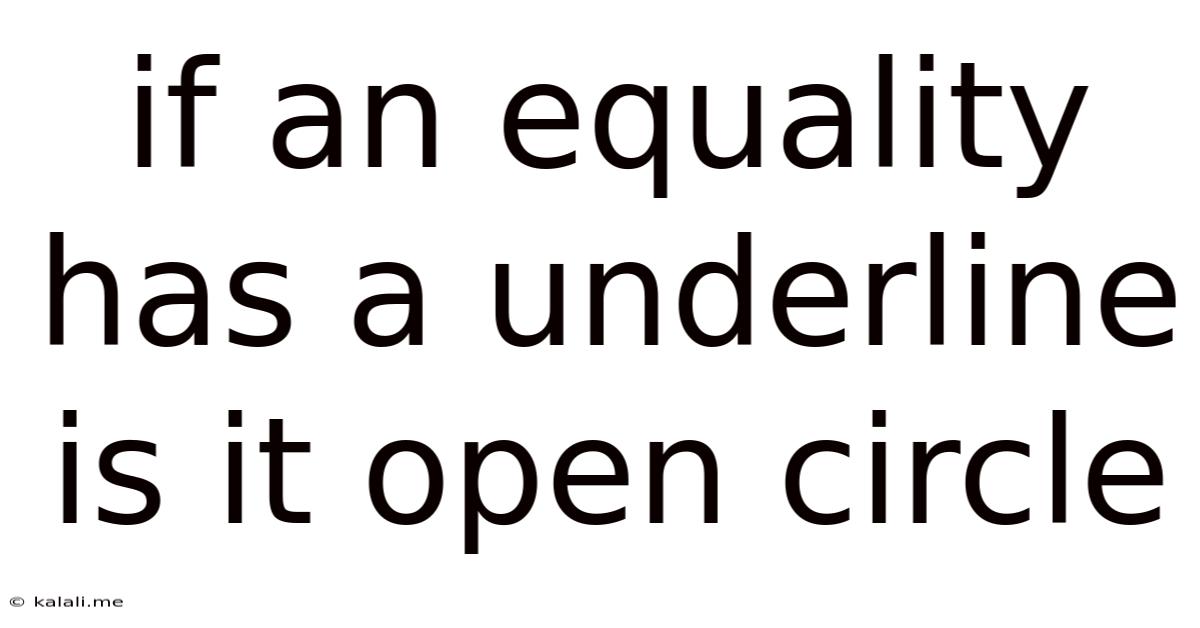If An Equality Has A Underline Is It Open Circle
Kalali
May 09, 2025 · 3 min read

Table of Contents
Understanding Inequalities: Open Circles and Closed Circles on Number Lines
When graphing inequalities on a number line, the choice between an open circle (○) and a closed circle (●) is crucial for accurately representing the solution set. This article will clarify the rules surrounding these symbols, focusing specifically on whether an inequality with an underline uses an open or closed circle. The short answer is: no, an inequality with an underline uses a closed circle.
Inequalities are mathematical statements comparing two expressions that are not equal. They use symbols like < (less than), > (greater than), ≤ (less than or equal to), and ≥ (greater than or equal to). The underline, as part of ≤ or ≥, signifies the inclusion of the number itself within the solution set.
Understanding the Symbols: <, >, ≤, ≥
-
< (Less Than): This symbol represents values strictly less than a given number. It always uses an open circle on a number line because the number itself is not included in the solution.
-
> (Greater Than): This symbol represents values strictly greater than a given number. It always uses an open circle because the number itself is not included in the solution.
-
≤ (Less Than or Equal To): This symbol represents values less than or equal to a given number. It always uses a closed circle because the number itself is included in the solution. The underline is the key indicator of this inclusion.
-
≥ (Greater Than or Equal To): This symbol represents values greater than or equal to a given number. It always uses a closed circle because the number itself is included in the solution. The presence of the underline is what makes the difference.
Visualizing Inequalities on a Number Line
Let's illustrate with examples:
Example 1: x < 5
This inequality represents all values of x strictly less than 5. On a number line, this would be represented by an open circle at 5 and an arrow extending to the left, indicating all numbers smaller than 5.
Example 2: x ≥ -2
This inequality represents all values of x greater than or equal to -2. The number line would show a closed circle at -2 and an arrow extending to the right, encompassing -2 and all larger numbers. The closed circle directly signifies that -2 is part of the solution set.
Example 3: y ≤ 10
Similar to Example 2, this inequality includes 10 in its solution set. The number line would have a closed circle at 10 and an arrow pointing to the left.
Example 4: z > 1
Here, 1 is not included in the solution set. Therefore, you'd see an open circle at 1 on the number line with an arrow pointing right, representing all values greater than 1.
Key Takeaway
The presence of the underline (as in ≤ or ≥) is the defining factor determining whether you use a closed or open circle when graphing an inequality on a number line. An underline always indicates a closed circle, showing that the boundary number is included in the solution set. Without the underline (< or >), you always use an open circle. Remembering this simple rule will ensure accurate representation of inequalities on a number line.
Latest Posts
Latest Posts
-
Where Is The 3 In Riddle Transfer
Jul 03, 2025
-
How Much Does A Water Bottle Weight
Jul 03, 2025
-
How Many Inches Is Half A Yard
Jul 03, 2025
-
How Old Are You If Your Born In 1996
Jul 03, 2025
-
How Many Water Bottles In 64 Ounces
Jul 03, 2025
Related Post
Thank you for visiting our website which covers about If An Equality Has A Underline Is It Open Circle . We hope the information provided has been useful to you. Feel free to contact us if you have any questions or need further assistance. See you next time and don't miss to bookmark.